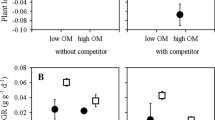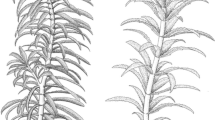Summary
Glasshouse competition experiments with Hydrilla verticillata (L.f.) Royle indicate that plants grown from turions are weaker competitors than those grown from tubers, when compared to the widely distributed macrophyte, Potamogeton pectinatus L. These results support an earlier hypothesis about the importance of propagule size for predicting the outcome of plant competition (Grace 1985; Schaffer and Gadgil 1980). Results of outdoor growth experiments indicate that even though Hydrilla plants from turions are relatively weaker competitors, they are able to grow succesfully in an existing macrophyte bed composed of either, P. pectinatus or P. gramineus. During the early stages of Hydrilla invasion into an area of existing macrophytes, native plants may coexist with Hydrilla. However, once the abundance of Hydrilla tubers in the sediment increases, Hydrilla may displace existing plants.
Similar content being viewed by others
References
Agami M, Waisel Y (1985) Inter-relationships between Najas marina L. and three other species of aquatic macrophytes. Hydrobiologia 126:169–173
Anderson LWJ (1985) Prelimianry research on monoecious hydrilla. U.S. Army Corps of Engineers Miscellaneous Paper A-854, pp 185–189
Anderson MR, Kalff J (1986) Regulation of submerged aquatic plant distribution in a uniform area of a weedbed. J Ecol 74:953–961
Barko JW, Adams MS, Clesceri NL (1986) Environmental factors and their consideration in the management of submersed aquatic vegetation: a review. J Aquat Plant Manage 24:1–10
Bliss CI (1970) Statistics in biology, vol 2. McGraw-Hill Book Co, New York
Carter V, Rybicki N (1986) Resurgence of submersed aquatic macrophytes in the tidal Potomac River, Maryland, Virginia, and the District of Columbia. Estuaries 9:368–375
Carpenter SR, Lodge DM (1986) Effects of submersed macrophytes on ecosystem processes. Aquat Bot 6:341–370
Connolly J (1987) On the use of response models in mixture experiments. Oecologia 72:95–103
Firbank LG, Watkinson AR (1985) On the analysis of competition within two-species mixtures of plants. J Appl Eco 22:503–517
Firbank LG, Watkinson AR (1986) Modelling the population dynamics of an arable weed and its effects upon crop yield. J Appl Ecol 23:147–159
Grace JB (1985) Juvenile vs. adult competitive abilities in plants: size-dependence in cattails (Typha). Ecology 66:1630–1638
Grace JB, Wetzel RG (1981) Habitat partitioning and competitive displacement in cattails (Typha): experimental field studies. Am Nat 118:463–474
Grace JB, Wetzel RG (1982) Niche differentiation between two rhizomatous plant species: Typha latifolia and Typha angustifolia. Can J Bot 60:46–57
Law R, Watkinson AR (1987) Response-surface analysis of two species competition from an experiment on Phleum arenarium and Vulpia fasciculata. J Ecol 75:871–886
McCreary NJ, Carpenter SR (1987) Density-dependent growth interactions between Eleocharis acicularis (L.) R. & S. and Juncus pelocarpus forma submersus Fassett. Aquat Bot 27:229–241
McCreary NJ, Carpenter SR, Chaney JE (1983) Coexistence and interference in two submersed freshwater perennial plants. Oecologia (Berlin) 59:383–396
McFarland DG, Barko JW (1987) Effects of temperature and sediment type on growth and morphology of monoecious and dioecious Hydrilla. J Freshwater Ecol 4:245–252
Motomura S, Shinozaki K, Yoda K (1986) Competition between two similar plant varieties, green shrunk perilla and red shrunk perila, in mixed cultures. Bot Mag 99:395–405
Ogawa H (1961) Experimental studies on the crowding effect in mixed populations of higher plants. Dep. Agric. Thesis, Kyoto Univ. (in Japanese)
Pieterse AH (1981) Hydrilla verticillata — a review. Abstr Trop Agric 7:9–34
Rejmánek M, Robinson GR, Rejmánková E (1989) Weed-crop competition: experimental designs and models for data analysis. Weed Sci 37:276–284
SAS Institute Inc (1985) SAS User's Guide: Statistics, 5th edn. SAS Institute Inc, Cary, NC
Schaffer WM, Gadgil MD (1980) Selection for optimal life histories in plants. In: Cody ML, Diamond JM (eds) Ecology and evolution of communities. Belknap Press, Cambridge, pp 142–157
Silvertown J (1987) Introduction to plant population ecology, 2nd edn.. Longman Scientific & Technical, Essex
Spencer DF (1986) Tuber demography and its consequences for Potamogeton pectinatus L. Proc EWRS/AAB 7th Symp Aquat Weeds 1986, pp 321–325
Spencer DF (1987) Tuber size and planting depth influence growth of Potamogeton pectinatus L. Am Midl Nat 118:77–84
Spencer DF, Anderson LWJ (1986) Photoperiod responses in monoecious and dioecious Hydrilla verticillata. Weed Sci 34:551–557
Spencer DF, Anderson LWJ (1987) Influence of photoperiod on growth, pigment composition and vegetative propagule formation for Potamogeton nodosus Poir. and Potamogeton pectinatus L. Aquat Bot 28:103–112
Spencer DF, Anderson LWJ, Ames MD, Ryan FJ (1987) Variation in Hydrilla verticillata (L.f.). Royle propagule weight. J Aquat Plant Manage 25:11–14
Spitters CJT (1983) An alternative approach to the analysis of mixed cropping experiments. 1. estimation of competition effects. Neth J Agric Sci 31:1–11
Stanton ML (1984) Seed variation in wild radish: effect of seed size on components of seedling and adult fitness. Ecology 65:1105–1112
Steward KK, Van TK (1987) Comparative studies of monoecious and dioecious hydrilla (Hydrilla verticillata) biotypes. Weed Sci 35:204–210
Steward KK, Van TK, Carter V, Pieterse AH (1984) Hydrilla invades Washington, D.C. and the Potomac. Am J Bot 71:162–163
Suehiro K, Ogawa H (1980) Competition between two annual herbs, Atriplex ginelini CA Mey and Chenopodium album L., in mixed cultures irrigated with seawater of various concentrations. Oecologia 45:167–177
Titus JE, Stephens MD (1983) Neighbor influences and seasonal growth patterns for Vallisneria americana in a mesotrophic lake. Oecologia 56:23–29
Van Wijk RJ (1983) Life-cycles and reproductive strategies of Potamogeton pectinatus L. in The Netherlands and the Camargue (France). Proc Internat Symp Aquat Macrophytes, Nijmegen 18–23 September 1983: pp 317–321
Watkinson AR (1981) Interference in pure and mixed population of Agyostemma githago. J Appl Ecol 18:967–976
Wright AJ (1981) The analysis of yield-density relationships in binary mixtures using inverse polynomials. J Agric Sci 96:561–567
Zar JH (1984) Biostatistical analysis, 2nd edn. Prentice-Hall Inc Englewood Cliffs
Author information
Authors and Affiliations
Rights and permissions
About this article
Cite this article
Spencer, D.F., Rejmánek, M. Propagule type influences competition between two submersed aquatic macrophytes. Oecologia 81, 132–137 (1989). https://doi.org/10.1007/BF00377022
Received:
Accepted:
Issue Date:
DOI: https://doi.org/10.1007/BF00377022




